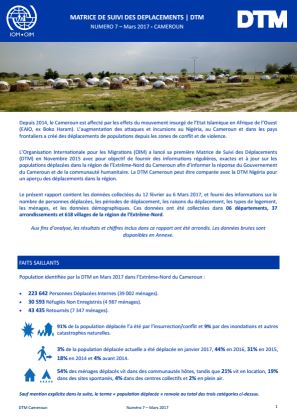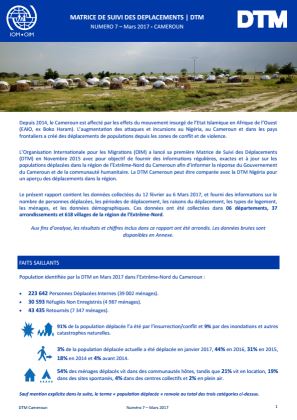-
Countries
-
Data and Analysis
-
Special Focus
-
Crisis Responses
Cameroon
Cameroon
IDPs tracked
Displacement Movements
1,044,000
IDMC 2023
Data collection round
About Cameroon
Since 2014, Cameroon has been affected by the effects of the insurgency movement of the Islamic State in West Africa (EAIO, ex Boko Haram). Increased attacks and incursions into Nigeria, Cameroon and neighboring countries have resulted in displacement from areas of conflict and violence.
The International Organization for Migration (IOM) launched its first issue of the Displacement Tracking Matrix (DTM) in November 2015 with the aim of providing regular, accurate and up-to-date information on displaced populations in the region. Far North of Cameroon to inform the response of the Government of Cameroon and the humanitarian community. The DTM Cameroon can be compared with the DTM Nigeria for an overview of the movements in the region.
Data collected includes the number of displaced persons, periods of displacement, reasons for displacement, types of housing and population data on displaced populations.
Contact
DTM Cameroon
DTMCameroon@iom.int
Current Donors
- Germany
- ECHO
- CERF
Cameroon — Displacement Report 8 (May 2017)
DTM identified an estimated 318,929 individuals comprising 228,443 IDPs, 32,459 unregistered refugees and 58,027 returnees. 674 villages were surveyed including 56 new villages. 96% of the assessed population were displaced due to armed conflict in the region.
Jun 26 2017
Cameroon — Displacement Report 8 (May 2017)
Cameroon — Displacement Dashboard 8 (May 2017)
DTM identified 228,443 internally displaced persons, 32,459 unregistered refugees and 58,027 returnees. 8% of the displaced population was displaced by flooding and other natural disasters while the vast majority (91%) was displaced by conflict.
Jun 05 2017
Cameroon — Displacement Dashboard 8 (May 2017)
Cameroun — Rapport de Déplacement 7 (Mars 2017)
Depuis 2014, la République du Cameroun a pu ressentir les effets de l’insurrection de l’Etat Islamique en Afrique de l’Ouest (ISWA, anciennement Boko Haram).
May 10 2017
Cameroun — Rapport de Déplacement 7 (Mars 2017)
Cameroon — Displacement Report 7 (March 2017)
Population identifiée par la DTM en Mars 2017 dans l’Extrême-Nord du Cameroun : 223 642 personnes déplacées internes (39 002 ménages), 30 593 réfugiés non enregistrés (4 987 ménages) et 43 435 retournés (7 347 ménages).
Mar 06 2017
Cameroon — Displacement Report 7 (March 2017)
Cameroun — Enquête sur les Intentions de Retour Ronde 6 (Janvier 2017)
Dans le cadre de sa sixième phase de la Matrice de Suivi des Déplacements (DTM), l’Organisation Internationale pour les Migrations (OIM) a mené une Enquête sur les Intentions de Retour ciblant les Personnes Déplacées Internes (PDIs) dans la région de l’Extrême-Nord du Cameroun.
Cameroon — Displacement Dashboard 7 (March 2017)
En mars, DTM a enregistré 297,670 individus (51,336 ménages) déplacés dont 223,642 IDPs et 30,593 réfugiées non-enregistrés.
Mar 06 2017
Cameroon — Displacement Dashboard 7 (March 2017)
Cameroun — Rapport de Déplacement 6 (Janvier 2017)
Depuis 2014, la République du Cameroun a pu ressentir les effets de l’insurrection de l’Etat Islamique en Afrique de l’Ouest (ISWA, anciennement Boko Haram).
Cameroon — Return Intention Survey Round 6 (January 2017)
As part of its sixth round of the Displacement Tracking matrix (DTM), the International Organization for Migration (IOM) conducted a Return Intention Survey targeting IDPs in the Far North Region of Cameroon.
Cameroun — Rapport de Déplacement 5 (Octobre 2016)
Depuis 2014, la République du Cameroun a pu ressentir les effets de l’insurrection de l’Etat Islamique en Afrique de l’Ouest (ISWA, anciennement Boko Haram).
Cameroun — Enquête sur les Intentions de Retour Ronde 5 (Octobre 2016)
Dans le cadre de sa cinquième phase de la Matrice de Suivi des De placements (DTM), l’Organisation Internationale pour les Migrations (OIM) a mene une Enquête sur les Intentions de Retour ciblant les Personnes Déplacées Internes (PDIs) dans la région de l’Extrême-Nord du Cameroun.
Cameroon — Return Intention Survey Round 5 (October 2016)
As part of its fifth round of the Displacement Tracking matrix (DTM), the International Organization for Migration (IOM) conducted a Return Intention Survey targeting IDPs in the Far North Region of Cameroon.
Cameroon — Displacement Report 6 (January 2017)
DTM identified 191,908 internally displaced persons (33,469 households), 23,430 unregistered refugees (4,066 households) and 35,665 returnees (6,366 households). 92% of the displaced population was displaced by the insurgency and 8% by flooding and other natural disasters.
Jan 02 2017
Cameroon — Displacement Report 6 (January 2017)
Cameroon — Displacement Dashboard 6 (January 2017)
DTM identified 191,908 internally displaced persons (33,469 households), 23,430 unregistered refugees (4,066 households) and 35,665 returnees (6,366 households). 92% of the displaced population was displaced by the insurgency and 8% by flooding and other natural disasters.
Cameroon — Displacement Dashboard 5 (October 2016)
DTM identified 198,889 internally displaced persons (76%), 26,743 unregistered refugees (10%) and 36,068 returnees (14%). 8% of the displaced population was displaced by flooding and other natural disasters while the vast majority (91%) was displaced by conflict.
Cameroon — Displacement Report 5 (October 2016)
DTM identified 198,889 internally displaced persons (35,630 households) and 36,068 returnees (6,946 households). 92% of the displaced population was displaced by the insurgency and 8% by flooding and other natural disasters.
Oct 31 2016
Cameroon — Displacement Report 5 (October 2016)
Cameroun — Enquête sur les Intentions de Retour Ronde 4 (Août 2016)
Dans le cadre de sa quatrième phase de la Matrice de Suivi des Déplacements (DTM), l’Organisation Internationale pour les Migrations (OIM) a mené une Enquête sur les Intentions de Retour ciblant les Personnes Déplacées Internes (PDIs) dans la région de l’Extrême-Nord du Cameroun.
Cameroon — Return Intention Survey Round 4 (August 2016)
As part of its fourth round, the Displacement Tracking matrix (DTM) conducted a Return Intention Survey targeting IDPs in the Far North Region of Cameroon.
Cameroun — Rapport de Déplacement 4 (Août 2016)
Depuis 2014, la République du Cameroun a pu ressentir les effets de l’insurrection de l’Etat Islamique en Afrique de l’Ouest (ISWA, anciennement Boko Haram).
Sep 15 2016
Cameroun — Rapport de Déplacement 4 (Août 2016)
Cameroon — Displacement Dashboard 4 (August 2016)
DTM identified 181,215 internally displaced persons, 14,871 unregistered refugees and 32,023 returnees. 13% of the displaced population was displaced by flooding and other natural disasters while 84% were displaced by conflict.
Cameroon — Displacement Report 4 (August 2016)
In Northeastern Cameroon, 181,215 internally displaced persons (33,621 households), 14,871 unregistered refugees (2,617 households) and 32,023 returnees (6,188 households) were identified by DTM.
Aug 31 2016
Cameroon — Displacement Report 4 (August 2016)
Cameroun — Rapport de Déplacement 3 (Avril 2016)
Depuis 2014, la République du Cameroun a pu ressentir les effets de l’insurrection de l’Etat Islamique en Afrique de l’Ouest (ISWA, anciennement Boko Haram).
May 20 2016
Cameroun — Rapport de Déplacement 3 (Avril 2016)
Cameroon — Displacement Dashboard 3 (April 2016)
DTM identified 190,591 internally displaced persons (34,221 households), 8,251 unregistered refugees (1,650 households) and 39,833 returnees (7,828 households). 83% of the displaced population was displaced by the insurgency and 17% by flooding and other natural disasters.
Apr 29 2016
Cameroon — Displacement Dashboard 3 (April 2016)
Cameroon — Displacement Report 3 (April 2016)
DTM identified 190,591 internally displaced persons (34,221 households), 8,251 unregistered refugees (1,650 households) and 39,833 returnees (7,828 households). 83% of the displaced population was displaced by the insurgency and 17% by flooding and other natural disasters.
Apr 29 2016
Cameroon — Displacement Report 3 (April 2016)
Cameroun — Rapport de Déplacement 2 (Février 2016)
Depuis 2014, la République du Cameroun a pu ressentir les effets de l’insurrection de l’Etat Islamique en Afrique de l’Ouest (ISWA, anciennement Boko Haram).


























